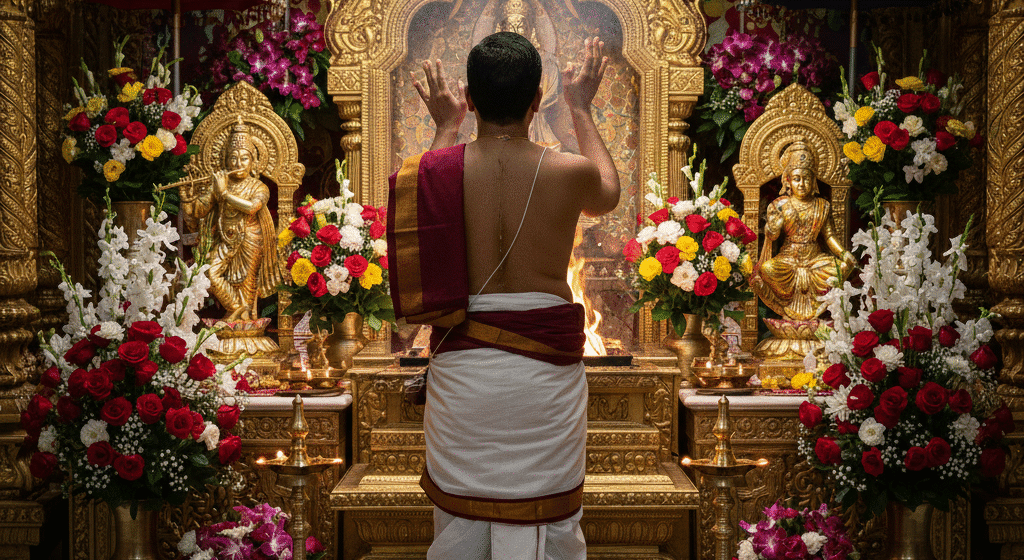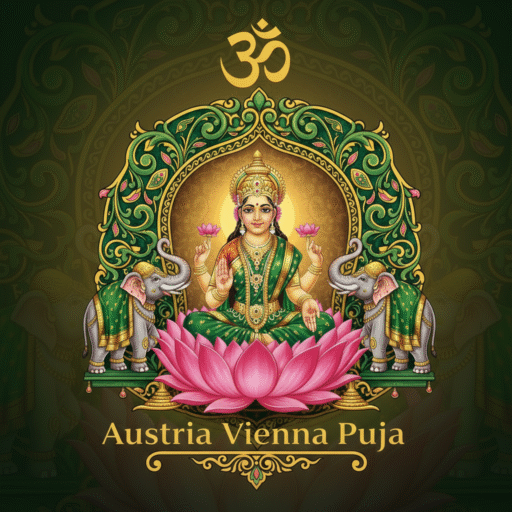
Puja
Note: Travel and accommodation expenses are to be paid extra .

Note: Travel and accommodation expenses are to be paid extra .
Puja, derived from Sanskrit meaning “to worship,” represents the core devotional practice in Hinduism through which practitioners establish direct communion with divine consciousness. Far from mere ritual performance, authentic puja embodies the philosophical principles articulated in the Upanishads—that the divine pervades all existence and can be approached through focused intention, sacred offerings, and inner transformation.
In Austria’s growing Hindu community, puja serves not only as spiritual practice but as a vital link to ancestral wisdom, maintaining continuity with traditions that have guided spiritual seekers for millennia while adapting to contemporary European life.
Explore Hindu worship traditions: Puja – Britannica
The Bhagavad Gita (9.26) states that divine consciousness accepts even a leaf, flower, fruit, or water when offered with devotion, emphasizing that the sincerity of intention surpasses material value. This principle underlies all authentic puja—the ritual’s power resides not in mechanical execution but in the consciousness of the practitioner.
Puja establishes what the Yoga Sutras describe as surrender to divine consciousness, creating a sanctified field where ordinary materials become vehicles for spiritual energy. Through this conscious offering, practitioners transcend the illusion of separation between self and divine, experiencing what the Upanishads call recognition of one’s essential unity with cosmic consciousness.
An experienced priest understands these subtle dimensions, guiding participants toward authentic engagement rather than superficial ceremony. This knowledge distinguishes genuine puja from mechanical ritual performance.
Vedic puja originates in the four Vedas—Rigveda, Samaveda, Yajurveda, and Atharvaveda—composed over three millennia ago. These texts represent humanity’s earliest systematic exploration of the relationship between human consciousness and cosmic forces. The Yajurveda particularly details ritual procedures, emphasizing that precise execution aligns human action with universal order (Rta).
Unlike later devotional movements, Vedic practice understands deities not as separate entities but as principles governing natural and spiritual domains. Agni (fire) represents transformation; Indra embodies strength and clarity; Varuna maintains cosmic law. Worship of these forces acknowledges humanity’s interdependence with natural principles and seeks harmonious alignment with them.
Learn about Vedic philosophy: Vedas – Encyclopedia Britannica
Central to Vedic puja is Yajna—offerings rendered into sacred fire. The Bhagavad Gita (3.14-15) describes how existence itself emerged from Yajna and is sustained through it. This recognizes that conscious sacrifice—offering one’s limited ego to universal consciousness—underlies all spiritual progress.
In Vedic ritual, Agni serves as messenger between human and divine realms. Offerings transformed by fire ascend as subtle energy, while the fire’s blessing descends as grace. This bidirectional flow represents the fundamental principle of spiritual exchange—giving and receiving that maintains cosmic balance.
Vedic practice emphasizes meticulous ritual execution, but this precision serves a deeper purpose. The Mimamsa philosophy explains that correct ritual performance establishes resonance with cosmic patterns. Just as musical instruments must be precisely tuned to create harmony, ritual elements must align correctly to establish the intended spiritual effect.
However, the Brihadaranyaka Upanishad clarifies that ritual alone cannot produce ultimate liberation. Vedic puja serves as preparation—purifying consciousness and establishing discipline—but must eventually yield to direct knowledge of one’s essential nature.
Tantra emerged around the 6th century CE, offering a radical reinterpretation of spiritual practice. While Vedic tradition often emphasized transcendence of material existence, Tantra proposes that the material world itself is a manifestation of divine consciousness (Shakti). Therefore, spiritual practice should engage directly with material reality, transforming rather than escaping it.
The Kashmir Shaivism tradition, one of Tantra’s philosophical peaks, teaches that consciousness (Shiva) and energy (Shakti) are inseparable aspects of one reality. Tantric puja works with this understanding, utilizing material elements, visualization, and energy practices to awaken dormant spiritual potential (Kundalini).
Explore Tantric philosophy: Tantra – Britannica
Tantric practice emphasizes Shakti—the dynamic, creative aspect of divinity often represented as the Divine Mother. Unlike the more patriarchal structure of Vedic ritual, Tantra acknowledges the feminine principle as primary. Deities like Kali and Durga represent not merely power but the transformative force that destroys limitation and ignorance, revealing underlying truth.
This emphasis reflects Tantra’s core recognition: true spiritual power lies in embracing and transforming all aspects of existence rather than rejecting what seems impure or limiting. This approach profoundly impacts how practitioners relate to their own bodies, emotions, and desires—transforming potential obstacles into vehicles for spiritual awakening.
While Vedic puja follows established protocols, Tantric practice allows significant adaptation based on the practitioner’s constitution, spiritual maturity, and guidance from a qualified teacher (Guru). The Tantras themselves state that what purifies one practitioner may not suit another, emphasizing individualized spiritual practice (Sadhana).
This flexibility extends to the use of unconventional elements in ritual. Some Tantric traditions employ what would be forbidden in orthodox Vedic practice, deliberately transgressing social norms to transcend dualistic thinking. However, such practices require proper context and guidance; misunderstood or misapplied, they can lead to confusion rather than liberation.
Tantric puja employs three primary technologies: mantra (sacred sound), yantra (sacred geometry), and inner visualization. Together, these establish a multidimensional field of consciousness.
Mantras in Tantra are not merely prayers but sound-formulas believed to directly affect consciousness at subtle levels. The specific phonemes and rhythms create resonance patterns that can awaken dormant aspects of awareness.
Yantras provide visual focal points representing cosmic principles in geometric form. Meditation on these forms reorganizes mental patterns, creating alignment with universal structures.
Inner Visualization develops the capacity to perceive subtle realities beyond ordinary sensory experience, training consciousness to recognize its own creative power.
| Aspect | Vedic Approach | Tantric Approach |
|---|---|---|
| Ritual Structure | Precisely defined procedures from ancient texts | Adaptation based on circumstance and practitioner maturity |
| Understanding of Divinity | Distinction between worshiper and divine | Ultimate dissolution of distinction; recognition of divine nature |
| Practice Focus | Collective participation and social cohesion | Individual transformation and direct experience |
| Objective | Blessings for prosperity, health, harmony | Liberation through direct realization of divine nature |
The Austrian Hindu community maintains these ancient practices while adapting to European life. Temples and cultural organizations provide spaces for traditional worship, celebrating festivals like Diwali, Navaratri, and Mahashivaratri with full ceremonial authenticity.
This preservation of tradition in diaspora serves multiple purposes. For Hindu families, puja maintains connection to ancestral wisdom, transmitting spiritual values to children growing up in a different cultural context. For the broader Austrian society, these practices offer windows into profound philosophical traditions addressing universal human concerns—meaning, purpose, transcendence.
The practice of puja in Austria exemplifies how authentic spirituality transcends geographical and cultural boundaries. The principles underlying Vedic and Tantric worship—conscious intention, reverence for existence, transformation of consciousness—speak to fundamental human aspirations that know no borders.
Discover puja services:
Puja Services
Those interested in experiencing puja can connect with Hindu temples and cultural centers throughout Austria. Many organizations welcome sincere seekers regardless of background, offering explanations of rituals and their significance.
For those considering personal practice, guidance from an experienced teacher proves invaluable. Puja, especially Tantric practice, involves subtle dimensions that textual study alone cannot convey. A qualified guide ensures proper understanding and avoids common misconceptions, allowing practitioners to engage with full spiritual efficacy.
Discover Vedic consulting:
Vedic Consulting Services
What is the essential purpose of puja?
According to Vedantic philosophy, puja’s ultimate purpose is establishing conscious relationship with divine reality. While practitioners may seek specific blessings or benefits, the deeper function is transforming ordinary consciousness into recognition of its essential divine nature.
Can Vedic and Tantric elements be combined?
Yes. Many contemporary practitioners integrate elements from both traditions. The key is maintaining philosophical coherence and sincerity of intention. Some aspects combine naturally, while others require careful consideration to avoid contradiction.
What role does puja play in spiritual liberation?
The Bhagavad Gita teaches that puja, when performed as offering without attachment to results, purifies consciousness and prepares it for higher knowledge. Puja alone does not produce ultimate liberation, but it establishes the foundation—mental clarity, devotional intensity, ethical discipline—upon which liberating knowledge arises.
Why does Tantric puja include unconventional practices?
Certain Tantric traditions deliberately employ elements that conventional society considers impure or forbidden. The philosophical rationale is that liberation requires transcending all dualistic categorization—pure versus impure, sacred versus profane. Advanced practitioners transcend limiting mental patterns by consciously engaging what is typically rejected. However, such practices require proper context, preparation, and guidance.
How can puja practice benefit modern life?
Authentic puja cultivates qualities essential for meaningful contemporary existence: focused attention, reverence for life, recognition of interconnections, and inner peace. Regular practice creates psychological stability and spiritual depth that inform all aspects of daily living.
Where can I learn more about puja traditions?
Qualified teachers and authentic temples throughout Austria provide guidance suited to different spiritual interests and maturity levels. Beginning with basic instruction ensures proper foundation for deeper engagement with these profound practices.
For comprehensive exploration of Vedic and Tantric philosophy underlying these practices, consult Puja – Britannica which provides detailed examination of puja’s historical development and philosophical foundations. To understand the broader context of Hindu worship traditions and their varied expressions, Tantra – Britannica offers scholarly perspective on Tantric philosophy and its relationship to other Hindu traditions.
Vedic and Tantric puja represent complementary approaches to divine reality—one emphasizing ritual precision and cosmic order, the other personal transformation and direct experience. Both traditions offer profound resources for spiritual development, speaking to different temperaments and stages of spiritual maturity while maintaining Hinduism’s essential teachings on the nature of consciousness and its relationship to ultimate reality.
Whether drawn toward the structured precision of Vedic practice or the transformative intensity of Tantric approaches, sincere seekers find in puja a vehicle for profound spiritual engagement—one that honors thousands of years of wisdom while addressing the deepest aspirations of the human spirit.
Connect with authentic practice:
Sahadev Pandit Services
Britannica Resources
https://www.britannica.com/topic/Veda
https://www.britannica.com/topic/Dharma-shastra
https://www.britannica.com/topic/Sanskrit-language
https://www.britannica.com/biography/Panini-Indian-grammarian
https://www.britannica.com/topic/Hinduism/Practice
https://www.britannica.com/topic/Advaita-school-of-Hindu-philosophy
https://www.britannica.com/topic/Vedic-religion
Stanford Encyclopedia
https://plato.stanford.edu/entries/logic-india/
https://plato.stanford.edu/entries/god-ultimates/
Academic Journals & Databases
https://jstor.org
https://pdcnet.org
https://ijhp.bgrfuk.org
Oxford Centre for Hindu Studies
https://ochs.org.uk
https://ochsonline.org
Government & Archive Resources
Research Papers
https://papers.ssrn.com
Educational Institutions
https://vedanet.com
https://vedicscience.net
https://bhishmaiks.org
https://vedicwellnessuniversity.com
Additional Academic Resources
https://ijnrd.org
https://takshila.org.in
https://wisdomlib.org
https://cambridge.org
https://academic.oup.com
https://pmc.ncbi.nlm.nih.gov
